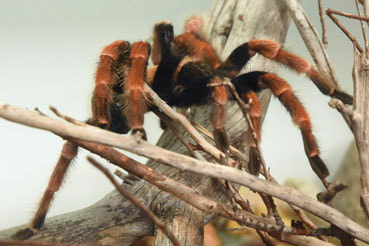Migalomorphs or megalomorphs are the infraorder of spiders. The name comes from the Greek mygalē, which means “shrew”, plus morphē, which means shape or form. The older name of the group is Orthognata, formed from the orientation of the canines, which are directed straight down and do not intersect with each other (like the araneomorphs). In 1802, Charles Athanas Valkenar separated the mygalomorph spiders into a separate genus Mygale, leaving all other spiders in Aranea.
What is Mygalomorphae?
Migalomorphic spiders are a moderately diverse group of more than 2,600 described species, currently subdivided into more than 300 genera and 15 families. Familiar mygalomorph include tarantulas and trap spiders, but there are many other distinctive taxonomic groups also.
Most mygalomorphs are relatively large terrestrial spiders and are considered as the gigantic spiders in the world. They live very long, about the age of 15 – 30 years. These spiders build a variety of silk structures to capture their prey, for their shelter and their protection.
Mygalomorphs retain several characteristics that are considered primitive for spiders; for example, they have two pairs of book lungs, simple rotating structures, etc.
Mygalomorph lines have a deep evolutionary history, as reflected in a rich fossil fauna dating back to the Lower Triassic, with fossils from several families dating back to the middle Cretaceous.
Mygalomorphae Facts
Vision:
Mygalomorphs have low vision, that is why they rely on different senses like their smell, taste, vibrations and tactile senses. To keep themselves away from their predators, they use their strong and powerful fangs and urticating hairs.
Life:
- Most araneomorph spiders in temperate regions live only one year, and sometimes two. However, mygalomorphs are known for their longevity: atypids can live for seven years, and teraphoses for over 20 years. As a rule, only women have a high life expectancy.
- In addition to normal death due to age, various other factors can affect a spider’s lifespan, such as lack of food and water, cannibalism, adverse habitats, adverse climatic conditions, fires, predation and the human destruction of their natural habitat.
Defensive Behaviour:
- Mygalomorphae uses different mechanisms to keep themselves safe from their enemies.
- They use their venom to kill their predators and prey. Since they have large fangs, they can deliver their venom very deep into the skin.
- When alarmed, some Theraphosidae emit a hissing, serpentine-like sound when the bristles on the chelicerae and palps rub against each other.
- They also use urticating hairs for their defence.
Prey: Mygalomorphae feed on a variety of different small animals, like;
Insects: Mygalomorph spiders love eating insects like beetles, ants, cockroaches, termites, grasshoppers, crickets, etc.
Arachnids: They also eat other spiders, solifugids and scorpions.
Millipedes: These spiders also feed onto millipedes, and; small reptiles, amphibians and snails
Natural Enemies: Mygaomorphs do not spend their life free from all worries; they are attacked by a variety of different predators and parasites.
They are a food source for several animals, such as birds, centipedes, lizards, insectivorous mammals, bats, mice, arachnids such as scorpions, and spiders. They are also affected by various fungi.
Mygalomorphae Bite
The most poisonous spider for humans is the male mygalomorph. It is commonly known as the Sydney Funnel Spider and has been credited with 14 known deaths. So, it is essential to stay away from the bite of these spiders, because they can be fatal for humans. Due to their big fangs, they can transfer the venom deep into the human skin, and the fangs can also rupture the skin.
Their chelicerae and canines are large and powerful, with abundant venom glands lying entirely inside the chelicerae. They use these weapons, combined with their size and strength, make mygalomorph a powerful predator.
Many of them are well adapted to killing other large arthropods and sometimes kill small mammals, birds and reptiles. Despite their intimidating appearance and reputation, most mygalomorph spiders are not harmful to humans, with the exception of Australian funnel-shaped spiders, especially those of the genus Atrax.
This is why it is advised to keep a distance from these spiders or destroy their habitats if found. In this way, one can avoid a lot of danger coming in the way because of these deadly spiders.
Mygalomorphae Size
Mygalomorph spiders are considered as one of the longest spiders found in the world. Their body is about 3.9 inches long, and their legs are 11 inches long, which makes this spider the longest of all.
Some Mygalomorph spiders are tiny and less than one millimetre in length.



